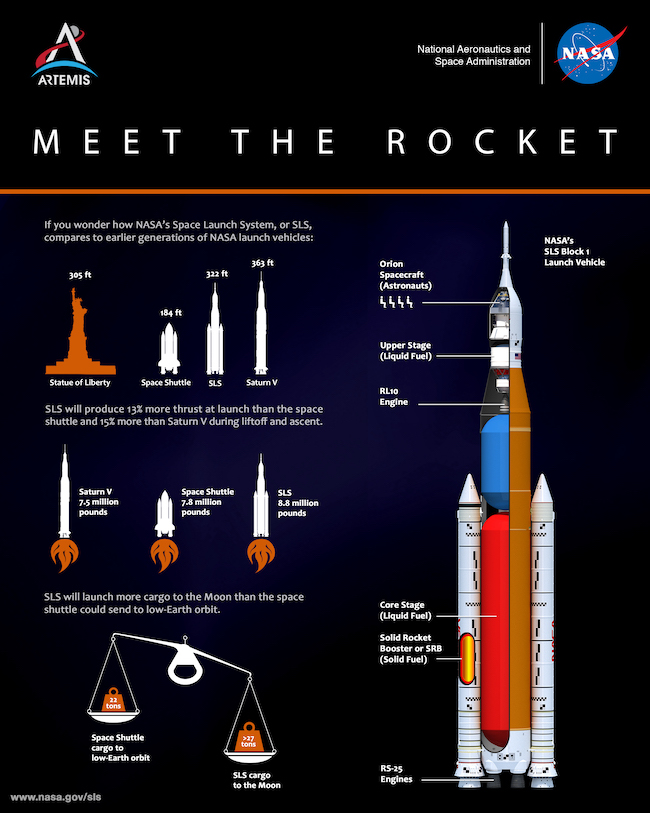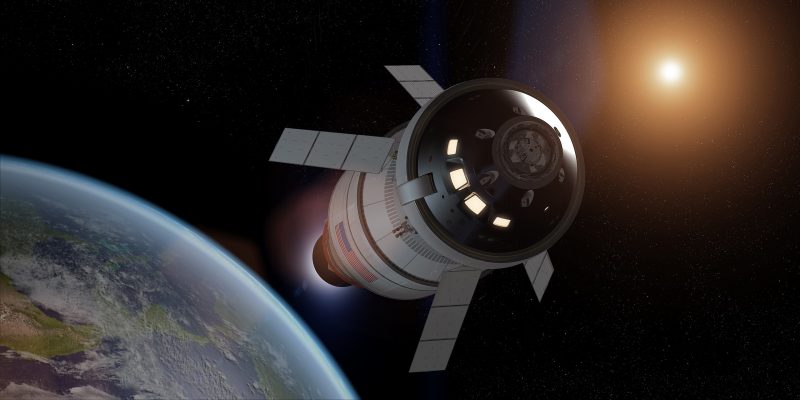Artemis 1: First of 3
The last humans on the moon left there on December 19, 1972. Now, the United States is preparing to return men – and the first woman (or women?) and first person (people?) of color – to the moon as early as 2025. The task requires a new launch system and much preparation. NASA says the plan isn’t just to land on the moon, or just to walk on the moon, but to explore more of it than the first astronauts did. The overall mission is called Artemis, for the Greek goddess most associated with the moon. At the time of this writing, the first preparatory mission, called Artemis 1, is scheduled to launch in March 2022.
NASA is collaborating with commercial and international partners on the Artemis program. The goal is to establish the first long-term human presence on the moon. Then, NASA says, it will use what it learns on and around the moon to take the next giant leap: sending the first astronauts to Mars.
Artemis 1 is an uncrewed mission. Its purpose is to test the inaugural flight of NASA’s Space Launch System (SLS), a rocket taller and more powerful than the mighty Saturn V rockets used during the Apollo program. Aboard SLS will be the Orion Multi-Purpose Crew Vehicle, flying to space for its first time since an Earth-orbiting test in 2014.
According to NASA, Artemis 1 will break records:
Orion will stay in space longer than any ship for astronauts has done without docking to a space station, and return home faster and hotter than ever before.
Okay then. It’s a first step. After it will be Artemis 2, a crewed flight that’ll perform tests in Earth orbit. It’s currently scheduled for 2024. Then, in 2025 – if the program can stay on schedule – the Artemis 3 crew of four people will gear up for the 236,000-miles-long (380,000-km-long) journey to the moon. Overall, they’ll be in space about a month. The four astronauts will spend six days at our natural satellite’s south pole.
The 2022 lunar calendars are here. Order yours before they’re gone!
Details of Artemis 1 mission
Visionaries have been dreaming for decades of a return to the moon. And – although NASA first announced the Artemis program in December 2017 – the development of the Orion crew capsule and the powerful SLS that’ll blast it into orbit officially began earlier, in 2011. For the Artemis 1 mission – now planned to go up in March 2022 – the mighty launch system will send the crew capsule aloft from Kennedy Space Center in Florida. They’ll launch from the historic Launch Complex 39, originally built as the Apollo program’s Moonport and later modified for the Space Shuttle program. NASA explained:
During launch and ascent, SLS will produce 8.8 million lbs. of maximum thrust, 15% more thrust than the Saturn V rocket.
It’ll need that much thrust to send the six million pounds (3 million kg) of vehicle into orbit. Orion won’t have a human crew during Artemis 1. But, as explained by Space.com:
… the commander’s seat will be occupied by a mannequin dressed in the Orion Crew Survival System, a special suit designed to help protect against radiation. Two radiation sensors will monitor radiation levels.
The mannequin will be strapped in, but the weightless environment also needs testing. So NASA is flying a ‘zero gravity indicator’ in the form of a Snoopy cuddly toy dressed in an iconic orange NASA jumpsuit. The comic strip character has a long association with lunar exploration: the crew of Apollo 10 used it as nickname for their lunar module.
How does Artemis 1 compare with Apollo?
Philippe Berthe, ESA’s project coordination manager for the module, said in a podcast interview:
The propulsion is largely the same. It is very comparable to the Apollo era.
But of course after 50 years, there’s been technological progress. Berthe commented, for example:
… There have been vast improvements in solar cells.
These are devices that directly convert the energy of light into electrical energy. The SLS will derive most of its power from its solar cells.
But naturally the biggest difference is computing power. Computers may have been on the horizon in the Apollo era – the late 1960s and early ’70s – but, as reported at ZMEscience.com:
Your smartphone is millions of times more powerful than the Apollo 11 guidance computers
So the Artemis program will benefit from our vast modern computing power. As Berthe said:
Computing power is another major improvement. We can program much more complex operations now. The crew don’t need to intervene directly in every nitty-gritty detail.
There was a lot of talk in Tom Wolfe’s famous 1979 book (later a classic movie) The Right Stuff about the idea of spam in a can. That was the intrepid test pilot Chuck Yeager’s description of the early Mercury flights, which reduced the role of the astronauts to that of passengers (rather than pilots).
The Apollo missions had pilots, and of course pilots are among the most glamorous of spacemen, both in science fiction and in reality. As we go further into the Artemis era, it’ll be fun to hear how much piloting takes place aboard the eventual Artemis 3 moon mission.

Man on the moon by 2025?
And of course there’s the decades-old debate about why we need to go to the moon at all. After all, over the past decades, we’ve learned a lot about the moon via robotic spacecraft, both orbiters and landers. Plenty of people will argue – and have argued since the Apollo era – that sending humans to the moon is a waste of time, money and resources. But the answer boils down to a number of things, one of them being efficiency. Berthe said:
An astronaut will do in a 6-hour [moonwalk] what a robot can do in 6 months. It is more expensive, but it is more efficient.
And the main reason, of course, is that the moon is a stepping stone to space. The moon’s gravity is only 1/6 of the Earth’s. It’s much easier to blast a rocket into space from the moon than from Earth. This makes the moon a great base for future exploration of the solar system.
The crew of Artemis 3 is aiming for the moon’s south pole, a place discovered in recent decades to have large amounts of water ice. Water contains oxygen, so processing it will make it possible for future astronauts to stay for longer batches of time, and even enabling us to have a permanent presence on the moon.
In the end, it’s all a part of humanity’s natural wanderlust. Future historians might look back on this as the moment humanity took a giant leap when returning to the moon, maybe this time for good.

Bottom line: Together with commercial and international partners, NASA plans for its Artemis mission to establish a permanent presence on the moon and to prepare for missions to Mars. The program’s first mission, Artemis 1, is scheduled to launch in March 2022.
Read more from EarthSky: NASA’s moon program – Artemis – boosted at White House press briefing
The post Artemis 1 and our return to the moon first appeared on EarthSky.
0 Commentaires